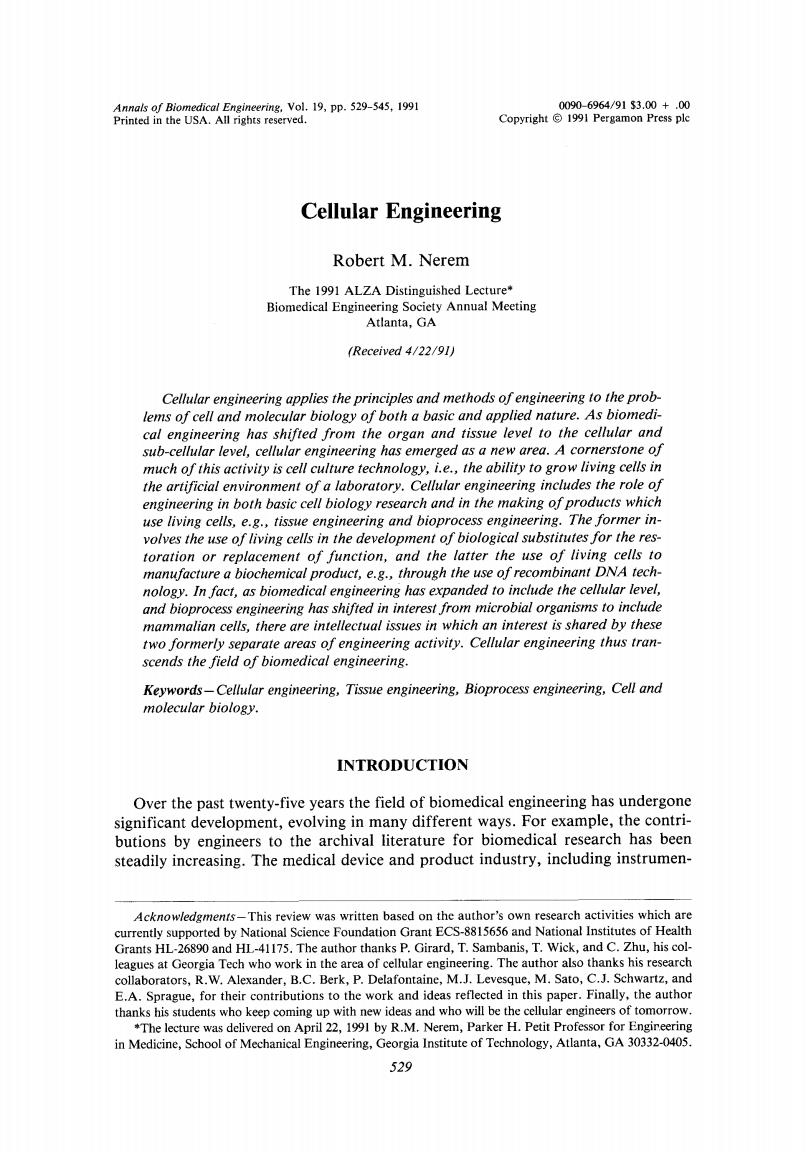正在加载图片...

Annals of Biomedical Engineering,Vol.19,pp.529-545,1991 0090-6964/91$3.00+.00 Printed in the USA.All rights reserved. Copyright1991 Pergamon Press plc Cellular Engineering Robert M.Nerem The 1991 ALZA Distinguished Lecture Biomedical Engineering Society Annual Meeting Atlanta,GA (Received 4/22/91) Cellular engineering applies the principles and methods of engineering to the prob- lems of cell and molecular biology of both a basic and applied nature.As biomedi- cal engineering has shifted from the organ and tissue level to the cellular and sub-cellular level,cellular engineering has emerged as a new area.A cornerstone of much of this activity is cell culture technology,i.e.,the ability to grow living cells in the artificial environment of a laboratory.Cellular engineering includes the role of engineering in both basic cell biology research and in the making of products which use living cells,e.g.,tissue engineering and bioprocess engineering.The former in- volves the use of living cells in the development of biological substitutes for the res- toration or replacement of function,and the latter the use of living cells to manufacture a biochemical product,e.g.,through the use of recombinant DNA tech- nology.In fact,as biomedical engineering has expanded to include the cellular level, and bioprocess engineering has shifted in interest from microbial organisms to include mammalian cells,there are intellectual issues in which an interest is shared by these two formerly separate areas of engineering activity.Cellular engineering thus tran- scends the field of biomedical engineering. Keywords-Cellular engineering,Tissue engineering,Bioprocess engineering,Cell and molecular biology. INTRODUCTION Over the past twenty-five years the field of biomedical engineering has undergone significant development,evolving in many different ways.For example,the contri- butions by engineers to the archival literature for biomedical research has been steadily increasing.The medical device and product industry,including instrumen- Acknowledgments-This review was written based on the author's own research activities which are currently supported by National Science Foundation Grant ECS-8815656 and National Institutes of Health Grants HL-26890 and HL-41175.The author thanks P.Girard,T.Sambanis,T.Wick,and C.Zhu,his col- leagues at Georgia Tech who work in the area of cellular engineering.The author also thanks his research collaborators,R.W.Alexander,B.C.Berk,P.Delafontaine,M.J.Levesque,M.Sato,C.J.Schwartz,and E.A.Sprague,for their contributions to the work and ideas reflected in this paper.Finally,the author thanks his students who keep coming up with new ideas and who will be the cellular engineers of tomorrow *The lecture was delivered on April 22,1991 by R.M.Nerem,Parker H.Petit Professor for Engireering in Medicine,School of Mechanical Engineering,Georgia Institute of Technology,Atlanta,GA 30332-0405. 529Annals ofBiomedicalEngineering, Vol. 19, pp. 529-545, 1991 0090-6964/91 $3.00 + .00 Printed in the USA. All rights reserved. Copyright 9 1991 Pergamon Press plc Cellular Engineering Robert M. Nerem The 1991 ALZA Distinguished Lecture* Biomedical Engineering Society Annual Meeting Atlanta, GA (Received 4/22/91) Cellular engineering applies the principles and methods of engineering to the problems of cell and molecular biology of both a basic and applied nature. As biomedical engineering has shifted from the organ and tissue level to the cellular and sub-cellular level, cellular engineering has emerged as a new area. A cornerstone of much of this activity is cell culture technology, i.e., the ability to grow living cells in the artificial environment of a laboratory. Cellular engineering includes the role of engineering in both basic cell biology research and in the making of products which use living cells, e.g., tissue engineering and bioprocess engineering. The former involves the use of living cells in the development of biological substitutes for the restoration or replacement of function, and the latter the use of living cells to manufacture a biochemical product, e.g., through the use of recombinant DNA technology. In fact, as biomedical engineering has expanded to include the cellular level, and bioprocess engineering has shifted in interest from microbial organisms to include mammalian cells, there are intellectual issues in which an interest is shared by these two formerly separate areas of engineering activity. Cellular engineering thus transcends the field of biomedical engineering. Keywords- Cellular engineering, Tissue engineering, Bioprocess engineering, Cell and molecular biology. INTRODUCTION Over the past twenty-five years the field of biomedical engineering has undergone significant development, evolving in many different ways. For example, the contributions by engineers to the archival literature for biomedical research has been steadily increasing. The medical device and product industry, including instrumenAcknowledgments-This review was written based on the author's own research activities which are currently supported by National Science Foundation Grant ECS-8815656 and National Institutes of Health Grants HL-26890 and HL-41175. The author thanks P. Girard, T. Sambanis, T. Wick, and C. Zhu, his colleagues at Georgia Tech who work in the area of cellular engineering. The author also thanks his research collaborators, R.W. Alexander, B.C. Berk, P. Delafontaine, M.J. Levesque, M. Sato, C.J. Schwartz, and E.A. Sprague, for their contributions to the work and ideas reflected in this paper. Finally, the author thanks his students who keep coming up with new ideas and who will be the cellular engineers of tomorrow. *The lecture was delivered on April 22, 1991 by R.M. Nerem, Parker H. Petit Professor for Engiv.eering in Medicine, School of Mechanical Engineering, Georgia Institute of Technology, Atlanta, GA 30332-0405. 529